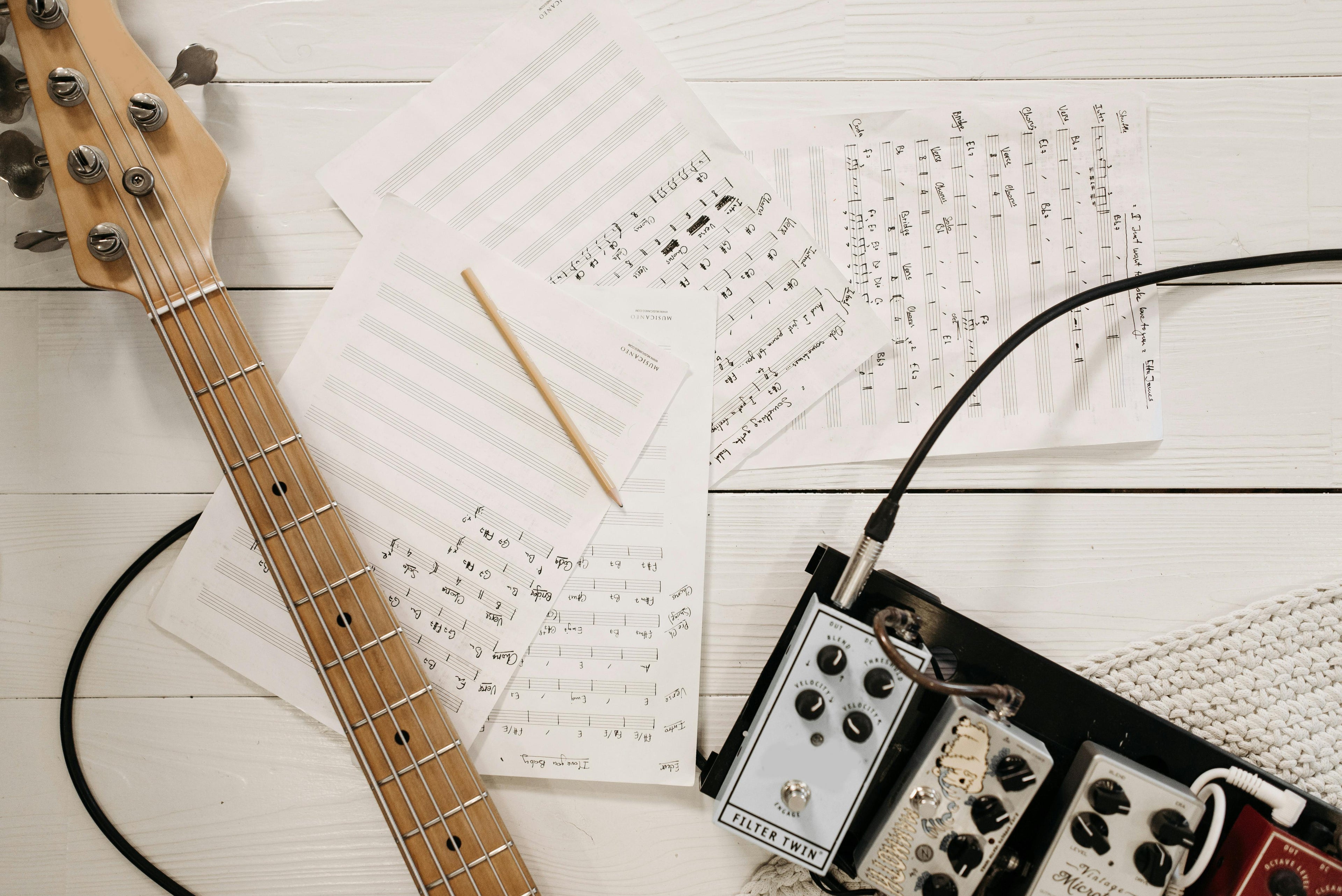Songwriting is one of the most rewarding aspects of making music, but it can also feel intimidating when you sit down at home with only a spark of an idea. Many beginners struggle with developing a smooth workflow that helps them expand fragments into fully realized songs. The truth is, building an effective songwriting workflow at home for beginners is not about having expensive tools or perfect skills. It is about understanding the creative process, creating habits, and learning how to capture and nurture inspiration. In this post, we will walk through how to take small ideas and grow them into complete songs, while also making your workflow feel natural, productive, and inspiring.
Creating the Right Environment for Songwriting at Home
The first step in establishing a strong songwriting workflow at home for beginners is setting up an environment that encourages creativity. Unlike a professional studio, most home spaces come with distractions and limitations, so it is important to design a space that makes you feel focused and inspired. This does not mean you need expensive gear. Sometimes all it takes is a clean desk, a comfortable chair, and good lighting. Small details like keeping a notebook nearby, arranging your instruments within reach, and reducing background noise can make a huge difference. The goal is to create a space that tells your brain this is where I make music. Over time, this ritual of working in the same spot will help train your creativity to flow more naturally.
Capturing Your Initial Song Ideas
Every song starts with a spark, whether it is a melody, a lyric, or a rhythm. One of the most important habits in any songwriting workflow at home for beginners is capturing those sparks before they disappear. Too often, great ideas vanish because they were not recorded or written down in time. Use your phone’s voice memo app, a small audio recorder, or even jot ideas down in a notebook. Do not worry about whether the idea is perfect. What matters is that it is captured. A short humming line, a chord progression, or even a lyric phrase can be the seed of an entire song later. Over time, you will build a personal library of raw ideas you can draw from whenever you sit down to write.
Starting With Melody, Lyrics, or Chords
When learning how to develop a songwriting workflow at home for beginners, you will discover that not every song starts the same way. Some begin with melody, others with chords, and others with lyrics. The key is to embrace whichever entry point feels most natural to you. If you have a lyric idea, try humming a melody that matches the mood. If you find yourself strumming chords on guitar or experimenting on piano, let that guide the direction of your song. The process is not linear. It is flexible. By experimenting with different starting points, you will become more comfortable writing songs under any circumstance, and you will learn which approach works best for your creativity.
Building a Strong Song Structure
One of the most challenging parts of songwriting at home is turning small fragments into full songs with clear structures. Beginners often struggle here because they do not know how to organize their ideas into verses, choruses, and bridges. A helpful songwriting workflow at home for beginners is to map out the skeleton of your song early. Decide whether you want a classic structure like verse chorus verse chorus bridge chorus, or something more experimental. Having a structure provides a roadmap, giving you a sense of where the song is headed. It also helps ensure your small idea grows into something complete rather than repeating endlessly without direction.
Developing Your Lyrics Into a Story
Lyrics can be one of the most personal and expressive parts of a song, but they also tend to be where beginners get stuck. When working on your songwriting workflow at home for beginners, think of lyrics as storytelling. Even if your song is only a few lines long, it should carry some emotion or meaning. Start with free writing, jotting down everything that comes to mind about your theme. Do not censor yourself at this stage. Later, you can refine and shape these raw thoughts into verses and choruses. Remember that great lyrics often balance honesty with imagery, allowing listeners to connect emotionally while also painting a vivid picture.
Expanding Chord Progressions
For many beginners, songs start with just two or three chords repeated over and over. While there is nothing wrong with simplicity, learning to expand your chord progressions can breathe new life into your songwriting. Experiment with relative minors, secondary dominants, or suspended chords to add variety and emotional depth. Even small shifts, like moving from a major to its relative minor, can change the entire feel of a section. Within a songwriting workflow at home for beginners, playing with progressions is often the stage where songs begin to feel fuller and more dynamic.
Creating Catchy Melodies
Melody is often the element listeners remember most, which is why it is so important to spend time developing one that feels strong. A practical approach within a songwriting workflow at home for beginners is to sing or hum freely over your chord progression and record everything, even the parts that feel silly. Later, listen back and pick out the strongest lines. Pay attention to rhythm, contour, and repetition. Great melodies often balance predictability with surprise. Once you have identified a hook or theme, refine it until it feels natural and singable.
Using Rhythm to Add Energy
Rhythm is sometimes overlooked in the songwriting process, but it is crucial for giving songs energy and drive. Even without drums, you can experiment with rhythm by strumming patterns, clapping, or using percussion apps. When working on a songwriting workflow at home for beginners, think about how the rhythm shifts between verses and choruses to create contrast. A more relaxed verse paired with a driving, upbeat chorus can add excitement and keep listeners engaged. Rhythm is also a great way to build transitions that guide the listener through different parts of your song.
Layering Sounds and Instruments
Once the foundation of your song is in place, layering can help expand its texture and atmosphere. This does not require professional studio gear. You can achieve a lot with a simple digital audio workstation and a few instruments. Layer a second guitar line with a different picking pattern, add harmonies to your vocals, or use simple MIDI instruments to fill out the arrangement. Within a songwriting workflow at home for beginners, layering is where your song evolves from a skeleton into something fuller and more engaging.
Writing Effective Choruses
The chorus is often the centerpiece of a song, the part that listeners remember and sing along with. When learning a songwriting workflow at home for beginners, it helps to focus on contrast. Your chorus should stand out from your verses both musically and lyrically. Use stronger, catchier melodies, emphasize your main lyrical theme, and often raise the energy level compared to the verses. Repetition is key. Do not be afraid to repeat phrases so the hook sticks. The stronger your chorus, the more likely your song will connect with listeners.
Bridging Sections Smoothly
A common stumbling block for beginners is figuring out how to connect different sections of a song without making the transitions feel awkward. One strategy within a songwriting workflow at home for beginners is to use bridges or pre choruses. A bridge introduces new material, often shifting chords or melody to keep things fresh before returning to the chorus. Pre choruses, on the other hand, build anticipation and help transition smoothly from the verse into the chorus. Both techniques add variety and momentum, ensuring the song keeps moving forward.
Recording Demos for Feedback
Even if you are not focused on recording, making simple demos at home is invaluable. They do not have to be perfect, just enough to capture the song’s structure and feel. As part of a songwriting workflow at home for beginners, demos help you step back and hear your song as a listener would. You can also share them with friends, collaborators, or online communities for feedback. This outside perspective often reveals strengths and weaknesses you might not have noticed while writing.
Revising and Editing Your Songs
No song is perfect on the first try. Revision is an essential stage of any songwriting workflow at home for beginners. After writing, take a break and return with fresh ears. Ask yourself whether each section serves the song’s emotional core, and cut or rewrite anything that does not. Do not be afraid to experiment. Sometimes changing a single lyric, chord, or melody can elevate an entire piece. The editing process can feel slow, but it is where many songs transform from good to great.
Finishing Songs Instead of Abandoning Them
Many beginners struggle with unfinished songs piling up. One of the most important lessons in a songwriting workflow at home for beginners is learning how to finish. It is tempting to move on to new ideas, but completing songs teaches discipline and sharpens your craft. Even if the result is not perfect, finishing gives you a sense of accomplishment and helps you grow as a songwriter. Over time, this habit builds confidence and ensures you have a body of work to reflect on and improve.
Staying Inspired Over the Long Term
Songwriting is a journey, and maintaining inspiration is part of the process. As you develop your songwriting workflow at home for beginners, remember to feed your creativity with outside influences. Listen to new genres, read poetry, watch films, or collaborate with other musicians online. Sometimes stepping away from music entirely for a short while can spark fresh ideas. The more you expose yourself to new experiences, the more material you will have to draw from in your songs.
Embracing Your Unique Voice
At the end of the day, your songs should sound like you. It is easy for beginners to compare themselves to professional artists and feel discouraged, but part of developing a songwriting workflow at home for beginners is embracing your individuality. Your perspective, your emotions, and your creativity are what make your songs stand out. Do not chase perfection. Chase authenticity. The more you write, the more your unique style will emerge, and that is what listeners will connect with most.
Conclusion
Building a songwriting workflow at home for beginners is about more than just writing lyrics or chords. It is about developing habits, creating structure, and learning to nurture small ideas into complete songs. By setting up a creative environment, capturing sparks of inspiration, experimenting with melody and chords, and embracing revision, you can consistently transform fragments into finished pieces. The process requires patience, but each song you complete adds to your growth as a songwriter. Whether you are writing for yourself or sharing your music with the world, learning how to turn small ideas into full songs is one of the most fulfilling skills you can develop.

